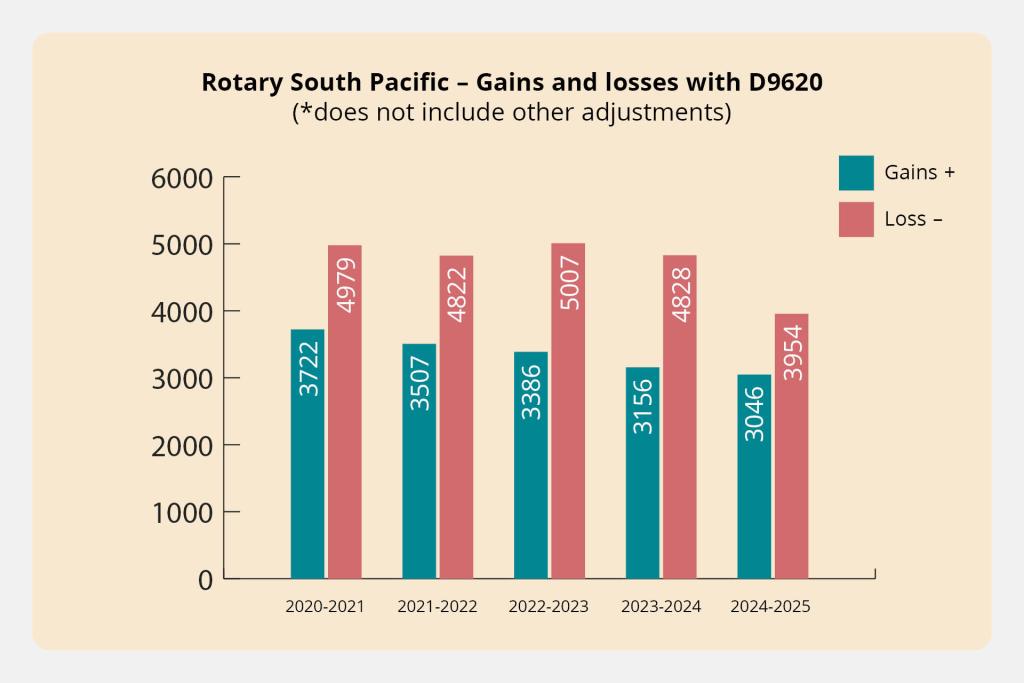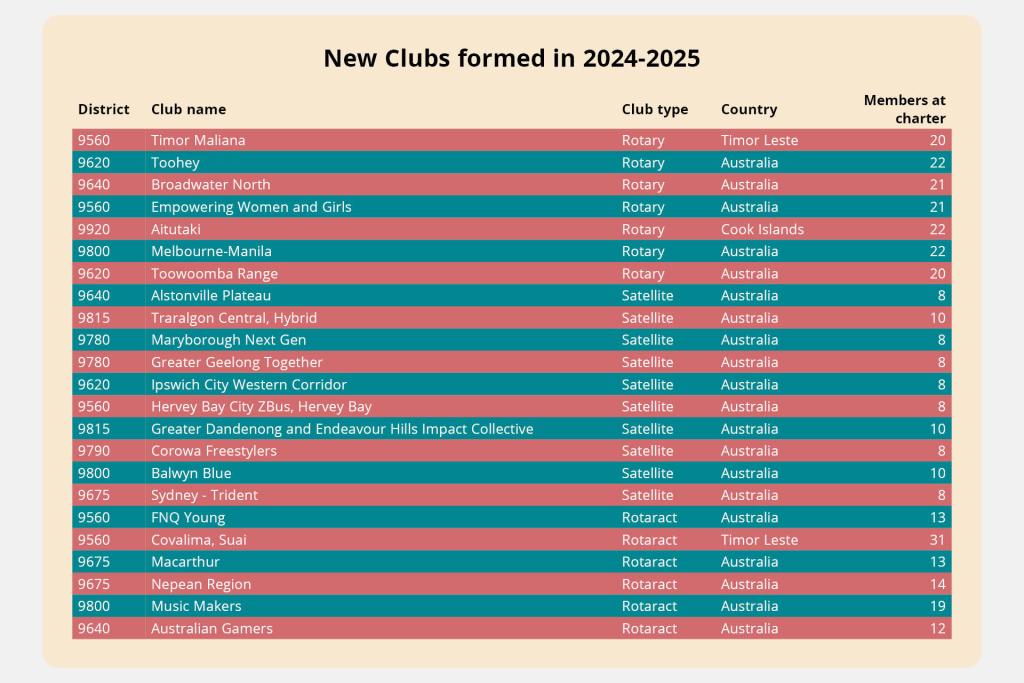Celebrating membership achievements of Rotary Zone 8 in 2024–25
A year of transformation, growth, possibilities and new learnings.
WORDS: PDG Andy Rajapakse. Membership Director, Rotary International Zone 8 Regional Council.
Last Rotary year, more than ever, was defined by resilience, innovation and the collective will to embrace change. It is only fitting then that we pause to reflect on and celebrate the extraordinary achievements, breakthroughs and lessons that have shaped our courageous journey.
Congratulations are due to every Rotary member and their families, club officers, district governors, Rotary community leaders and Rotary staff across Zone 8. Your unwavering commitment and collaborative spirit have driven a significant turnaround in our membership trends, unlocking new possibilities for engagement and growth.
Even in the midst of challenge, you kept the torch of service burning bright, demonstrating that progress does not always move in leaps, but often in steady, determined steps. As we support one another and push for positive change, let us take a moment to celebrate just how far we have come. There is no elevator to success. We must take
the steps!
The Rotary year 2024–25 stands as a beacon of transformation for Zone 8, the largest maritime Rotary region in the world spanning Australia, New Zealand, Fiji, Timor Leste, Cook Islands, Norfolk Island, Papua New Guinea, French Polynesia, Vanuatu, Solomon Islands, Nauru, Kiribati, Samoa, American Samoa, New Caledonia and Tonga. Today, our Rotary membership landscape has shifted dramatically. We have 26,400 Rotary members in 1,167 Rotary clubs across these 16 beautiful countries. As of 1 July 2025, Rotary International comprised 36,498 Rotary clubs with 1,124,681 members in more than 200 countries and territories.
Major achievements and milestones
Our net membership loss reduced by 42 per cent: as of 1 July 2025, Zone 8 ended the Rotary year with a net loss of 912 members, a dramatic improvement from the 1,579 lost during 2023–24. This is the lowest net loss since 2017.
This reversal in a long-standing decline is testament to the collaborative efforts of clubs, community leaders, district governors, pilot teams and the Regional Council. Through shared leadership and a club-focused approach, membership growth became the number one internal priority of clubs across our zone.
Club experience is the cornerstone of Rotary: members join and leave clubs, not districts or regional bodies. The quality of club leadership and the club experience are central to retention and attraction, far outweighing financial factors such as dues.
The 104-year-old Rotary Club of Melbourne, the first Rotary club formed in Zone 8, attracted 27 new members and ended the year with a net gain of +15 to record 158 members and still the largest club in our zone. With annual dues around AU$800, AU$350 entrance fee and AU$67 weekly lunch, the club’s growth success proves that value for money, welcome, community and club leadership matter most to members.

Club membership highlights
Only 358 clubs out of 1,167 (30%) recorded net growth, while 598 clubs experienced net losses and 204 remained unchanged. This reflects both ongoing challenges and opportunities for renewal, especially for the 130 clubs with fewer than 10 members and the 365 clubs with 10–15 members. Forty-two per cent of our clubs have 15 or fewer members and they struggle each year to elect a new club president.
New club merger models, such as Greater Blue Mountains in D9685 in Australia and Mana Tangata in D9940 in New Zealand, offer a blueprint for smaller clubs seeking to stay relevant and impactful. Mergers and collaborations are not just about numbers; they’re about expanding Rotary’s reach and preventing burnout in ageing clubs.
Engagement with Rotary community leaders, district governors, district support teams, Rotary specialists and Regional Council Portfolio Teams is crucial for clubs seeking to rebuild and thrive. Under the regionalisation pilot, more resources and guidance are readily available to help every club elevate its member experience and impact.
Member attraction and retention
In 2024–25, on 30 June 2025, Zone 8 clubs attracted 3,046 new members and terminated 3,954, marking an almost 20 per cent reduction in member resignations (churn) compared to the previous two years (4,828 terminations in 2023–24; 5,007 in 2022-23).
In our Zone 8 Membership Strategy, launched in April 2024 via Zoom, we shared a key strategy to reduce member churn by 20 per cent. We achieved this. Looking forward, a key ambition for 2025–26 is to further reduce resignations by 25 per cent over last year, aiming for fewer than 3,400 terminations in this Rotary year. This is an ambitious dream. But if our dreams don’t scare us then they’re not big enough.
The pilot program underlines the importance of every member’s contribution to club growth and vitality. Whether participating directly or not, all clubs in Zone 8 are part of this movement for renewal.
Regional and demographic insights
As of July 1, 2025, we have 20,700 Rotarians in Australia, 5,100 in New Zealand and 151 in Fiji. Last year, Australia welcomed 2,382 new members and saw 3,004 terminations; New Zealand welcomed 522 new members with 849 terminations; Fiji added 35 and lost 15; the other 13 Pacific Island nations admitted 107 new members and terminated 86.
Youth and diversity: transforming for the future
The 38 new Rotary clubs formed in the past five years since 2020, including the seven formed in 2024-25, have 52 per cent female members and 19 per cent of members are under the age of 40. Overall, Zone 8 reached 32.5 per cent female members, surpassing Rotary’s global average of 29 per cent. My home District 9640 in Australia leads with 40 per cent female membership, ranking 70th worldwide. Clubs that embrace flexibility and innovative engagement models were more successful in attracting diverse and younger members.
Fit for Purpose program
Among the 83 clubs in the acclaimed Fit for Purpose program:
- 35 clubs (42%) met or exceeded expectations for growth or retention.
- 25 clubs (30%) recorded a net gain; 10 clubs (12%) remained stable; and 48 clubs (58%) experienced losses.
Our Zone 8 Club Culture Transformation Team Captain Mark Huddleston has provided further details on these trends (page 16), underscoring the importance of adapting club culture to
foster growth.

District and global comparisons
Of the 19 districts in Zone 8, only D9560, D9780 and D9920 recorded growth, while 11 districts reduced their net decline compared to last year. All our districts recorded net losses in 2023-24.
Three districts – D9620 (not in the pilot) D9560 and D9510 – each attracted over 200 new members. D9780 achieved the highest retention, with just 112 resignations. However, four districts in New Zealand and six in Australia had over 201 resignations, totalling more than 2,500 members, accounting for 62 per cent of all member resignations in the zone.
We aimed to form 15 new clubs in 2024–25 but exceeded this with 23 new clubs: seven Rotary clubs, 10 satellite clubs and six Rotaract clubs. Australia established five new Rotary clubs, 10 satellite clubs and five Rotaract clubs. The Cook Islands established one Rotary club, and Timor-Leste one Rotary and one Rotaract club.
The creation of satellite clubs has never been higher, with 10 new Rotary satellite clubs formed in a single year, setting a Zone 8 record. The workshops conducted across many districts by our New Style Club Team Captain PDG Michael Buckeridge and his team generated new enthusiasm in clubs to start satellite clubs.
Unique clubs like the Rotary Satellite Club of Sydney Trident, consisting mainly of Ukrainian migrants living in Sydney, extended by the 104-year-old Rotary Club of Sydney in D9675; the Rotary Satellite Club of Balwyn Blue, consisting of senior police officers in Victoria, extended by the Rotary Club of Balwyn in D9800; and the Rotary Satellite Club of Hervey Bay City ZBus, focusing on homelessness, extended by the Rotary Club of Hervey Bay City in D9560 represent innovative approaches to new Rotary clubs, each tailored to meet specific community needs and attract diverse members.
Rotary club terminations in Zone 8 decreased to 27 in 2024–25, down from 51 in the previous year.
Globally, 767 new Rotary clubs were formed, while 803 were terminated in 2024–25.
India led the world with 213 new Rotary clubs formed (146 terminated). In Zone 10A, the Philippines started 25 new Rotary clubs (four terminated), and 16 in Great Britain & Ireland
(64 terminated).
District 9214 (Uganda and Tanzania) saw the largest number of new clubs formed in a single district, with 19.
The minimum members required today to form a new Rotary club is 15 and for a satellite club it is eight.
Looking ahead: embracing a new era of volunteerism
Transformation is slow. It’s a frustrating journey. For those who have weathered years of membership decline in Zone 8, it can be hard to believe that a genuine turnaround is underway. But the data speaks for itself, and the spirit of renewal is palpable. Membership growth reflects the value and experience clubs offer their members. Behind every statistic is a story of commitment, innovation and hope.
Zone 8’s Membership Portfolio Team, comprising 21 courageous members from 12 districts, alongside all Regional Council Portfolio Teams and Rotary staff, have poured their energy into supporting our club leaders, Rotary community leaders, district governors and officers on this path of continual improvement. Their dedication deserves our deepest appreciation. A wealth of resources on membership, public image, and diversity, equity and inclusion are available at creatingtomorrowrotary.org and rotarysouthpacific.org to enhance your Rotary journey.
Our Zone 8 is a model for the Rotary world, and the Rotary world is watching as we demonstrate what is possible with courage, vision and teamwork.
The achievements of 2024–25 prove that transformation is possible when members are engaged, leadership is sincere and innovative, and clubs are willing to evolve. As a new generation of volunteers emerge across Zone 8 seeking meaningful engagement, immediate leadership opportunities, and value for their time and money, the future of Rotary depends on our willingness to take more risks and reimagine our club models and the value we offer our fee-paying members.
With the momentum of the past year, I believe clubs in Zone 8 are poised for even greater growth and impact. The question for every club is: Are you fit to embrace the future of this new ‘volunteerism on demand’? The answer lies in our collective will to experiment, adapt, innovate and welcome a next generation of Rotarians. Let’s come together at our Zone 8 Conference in my home city the sunny Gold Coast from 31 October to 2 November and celebrate not only the numbers and milestones but the spirit of friendship, service and leadership that defines Rotary in Zone 8.
Cheers to another year of growth, possibilities and transformative impact!
Related news
Turning the tide on membership decline
Belmont Rotary reverses decline with a six-step plan, boosting membership and strengthening community engagement.
A new way of Rotary
Rotary Social Impact Network offers flexible, global membership for busy changemakers driving service and connection.
Designing for Tomorrow
Scarborough Rotary reinvents itself with modern vision, boosting engagement and achieving record membership growth.
Join our newsletter for the latest updates
"*" indicates required fields


